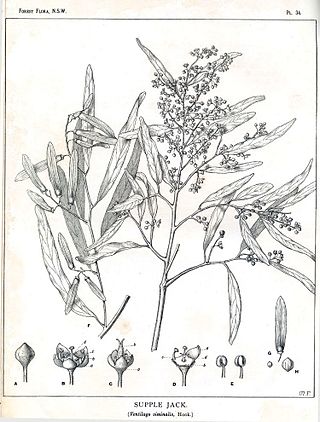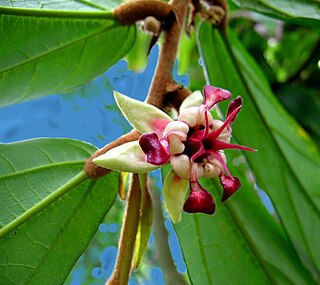
Alpinia is a genus of flowering plants in the ginger family, Zingiberaceae. Species are native to Asia, Australia, and the Pacific Islands, where they occur in tropical and subtropical climates. Several species are cultivated as ornamental plants.
Sterculiaceae was a family of flowering plant based on the genus Sterculia. Genera formerly included in Sterculiaceae are now placed in the family Malvaceae, in the subfamilies: Byttnerioideae, Dombeyoideae, Helicteroideae and Sterculioideae.

Kayea is a plant genus in the family Calophyllaceae. Its species range from Bangladesh and the eastern Himalayas to Sri Lanka, Indochina, Peninsular Malaysia, Borneo, Sumatra, the Philippines, New Guinea, and Queensland.

Licuala is a genus of palms, in the tribe Trachycarpeae, commonly found in tropical forests of southern China, Southeast Asia, the Himalayas, New Guinea and the western Pacific Ocean islands.

Brassaiopsis is a genus of shrubs in the family Araliaceae. There are about 45 species, distributed in Asia from the Himalaya through China, Vietnam, Thailand to Indonesia.

Ptychosperma is a genus of flowering plant in the family Arecaceae. Most are native to Australia and/or New Guinea, with a few in the Solomon Islands and in Maluku Province of eastern Indonesia. Some have been cultivated abroad as house or garden plants, and reportedly naturalized in certain regions

Ventilago is a genus of plants in the family Rhamnaceae. It includes about 40 species found in the tropics of South and SE Asia, Australasia, with one species each in Africa and Madagascar.

Ayenia is a genus of flowering plants in the mallow family, Malvaceae. It includes 216 species of subshrubs, shrubs, small trees, and lianas. They are native to the tropical Americas and southwestern United States, tropical Africa, and tropical Asia.

Appendicula, commonly known as stream orchids, is a genus of flowering plants in the family Orchidaceae. Orchids in this genus are epiphytic, lithophytic or rarely terrestrial plants herbs with many flat, often twisted leaves and small resupinate, white or greenish flowers. The sepals are free from each other but the lateral sepals and labellum are fused to the base of the column.

Byttnerioideae is a subfamily of the flowering plant family Malvaceae.

Tupistra is a genus of about 20 species of flowering plants found in south Asia, from southern China to Sumatra and Ambon Island. In the APG III classification system, it is placed in the family Asparagaceae, subfamily Nolinoideae.
Orestias is a genus of orchids. It has 4 known species, all native to central Africa, including the island of São Tomé in the Gulf of Guinea.
- Orestias elegansRidl. - São Tomé, Príncipe
- Orestias foliosaSummerh. in G.M.D.Troupin - Gabon, Zaire
- Orestias micranthaSummerh. - São Tomé, Cameroon, Equatorial Guinea
- Orestias stelidostachya(Rchb.f.) Summerh. - São Tomé

Wurfbainia is an Asian genus of flowering plants in the family Zingiberaceae. Species in this genus have been recorded from the Himalayas, South China, Indo-China and Western & Central Malesia. It has previously been placed as a synonym of Amomum.
Geostachys is a genus of plants in the family Zingiberaceae. It is native to southeast Asia.

Plagiostachys is a genus of plants in the Zingiberaceae. It is native to Southeast Asia.
Calophyllum elegans is a species of tropical flowering plants in the family Calophyllaceae. It grows as a 9.1 m tall tree. It is an endangered species native to Borneo, where it is confined to Sarawak.
Crepidium elegans is a species of epidendroid orchids in the tribe Malaxideae.
Wurfbainia elegans is a species of plant belonging to Zingiberaceae, the ginger family. It is endemic to the Philippines.
Brassaiopsis elegans is a species of shrub in the family Araliaceae.











